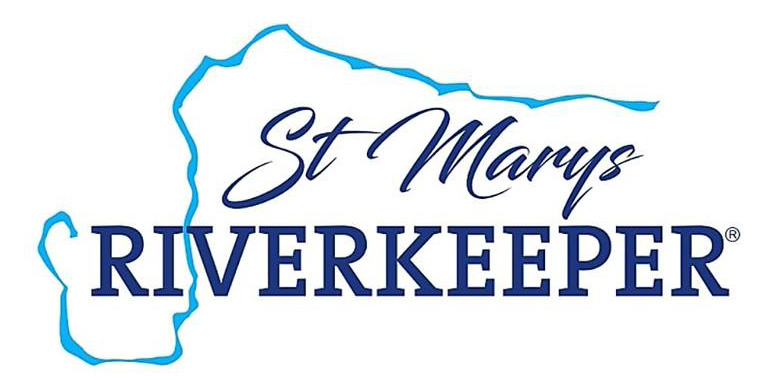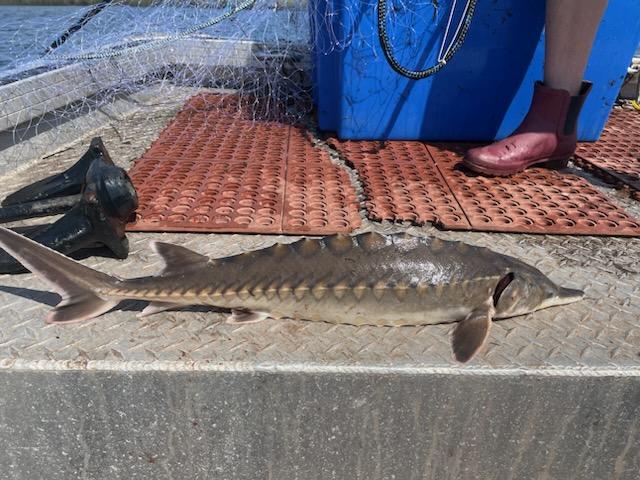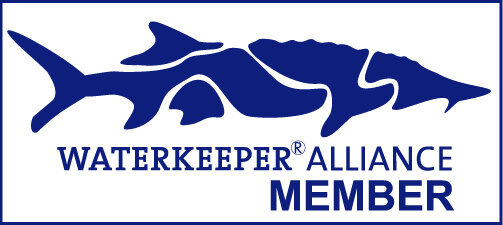"The completion of the 2023 sampling season represents the 8th year the FWCO has sampled the St. Marys River for Atlantic and shortnose sturgeon. This long-term monitoring program hopes to help in determining distribution, abundance, population dynamics, and recruitment trends."
Peninsular Florida FWCO

Critical Habitat
While the Shortnose Sturgeon resides in the river, it is unclear if they are a native, spawning population or if they are migrating adults from other populations that are present in the river seasonally. Atlantic Sturgeon were thought to be extirpated up until 2014 when a small, native population was rediscovered providing evidence that the river has favorable spawning locations. However, the spawning locations have not been identified. In 2017, NOAA’s National Marine Fisheries Service (NMFS) designated 7/8ths St. Marys River as critical habitat to protect the physical features to conserve the Atlantic Sturgeon. Critical habitat boundaries are defined based on best available data meaning that sturgeon may be found inside or outside of those boundaries and those boundaries may be altered as new data is collected.

Conservation objectives for the South Atlantic species is to ‘increase survival of all life stages and facilitate adult reproduction and juvenile and subadult recruitment into adult population”. The features essential for protection of sturgeon in the St. Marys River are:
- Hard bottom substrate (e.g., rock, cobble, gravel, limestone, boulder, etc.) in low salinity waters (i.e., 0.0-0.5 ppt range) for settlement of fertilized eggs and refuge, growth, and development of early life stages;
- Transitional salinity zones inclusive of waters with a gradual downstream gradient of 0.5-up to 30 ppt and soft substrate (e.g., sand, mud) between the river mouths and spawning sites for juvenile foraging and physiological development;
- Water of appropriate depth and absent physical barriers to passage (e.g., locks, dams, thermal plumes, turbidity, sound, reservoirs, gear, etc.) between the river mouths and spawning sites necessary to support:
- Unimpeded movement of adults to and from spawning sites;
- Seasonal and physiologically dependent movement of juvenile Atlantic sturgeon to appropriate salinity zones within the river estuary; and
- Staging, resting, or holding of subadults or spawning condition adults. Water depths in main river channels must also be deep enough (at least 1.2 m) to ensure continuous flow in the main channel at all times when any sturgeon life stage would be in the river.
- Water quality conditions, especially in the bottom meter of the water column, between the river mouths and spawning sites with temperature and oxygen values that support:
- Spawning;
- Annual and inter-annual adult, subadult, larval, and juvenile survival; and
- Larval, juvenile, and subadult growth, development, and recruitment. Appropriate temperature and oxygen values will vary interdependently, and depending on salinity in a particular habitat. For example, 6.0 mg/L DO or greater likely supports juvenile rearing habitat, whereas DO less than 5.0 mg/L for longer than 30 days is less likely to support rearing when water temperature is greater than 25 °C. In temperatures greater than 26 °C, DO greater than 4.3 mg/L is needed to protect survival and growth. Temperatures of 13 to 26 °C likely to support spawning habitat.
‘Any activity that affects those features directly (like dredging) or indirectly (sedimentation or saltwater intrusion) would affect Atlantic Sturgeon habitat’ also ‘groundwater pumping and industrial and development has impacted water quality through introduction of nutrients and other contaminants.’

Threat Assessment
It is known that river flow is positively related to Sturgeon spawning success. Favorable river flow allows sturgeon to access spawning grounds, increases dissolved oxygen levels in the water, keeps water temperatures cooler, keeps sediment moving rather than settling which can bury spawning grounds and larval habitat. River flow also prevents saltwater intrusion further upstream and helps offset the devastating impacts of sea level rise.
"The continued presence of Atlantic (and potentially Shortnose) sturgeon in the St. Marys River is especially important because this river is near or at the southern margin of each species’ range. Range contraction is a criterion for listing species under the Endangered Species Act, and the loss of sturgeon populations in this river would contribute to the further endangerment of these species."
Dr. Adam Fox, University of Georgia
A threat assessment is currently underway to determine what in the St. Marys River basin might negatively impact a successful recovery of the native species. However, any activity that reduces river flow is bad news. Some examples of harmful anthropogenic activity include, but not limited to:
– Industrial and residential development along waterfront (tributaries and main stem)
– Groundwater withdrawal resulting in reductions of river discharge
– Surface water discharge resulting in water quality issues including changes to dissolved oxygen, temperature, and sedimentation
– Loss of wetland protections and development right up the marsh line
– Sea level rise and saltwater intrusion
Conservation Efforts
Based on 10 years of sampling data, NOAA estimates the population size of St. Marys River Atlantic Sturgeon is 14 making these individuals vulnerable to disturbance. We are just beginning to learn more about the sturgeon of the St. Marys and additional research is needed to determine the best water quality and quantity needs for the continuation of this native species. “The loss of even a single individual may cause the collapse of the river’s population; diminish the genetic diversity of the South Atlantic DPS; and hasten the regional population’s continued decline” (Southeastern Law Center Twin Pines Mine public comment).
In 2023, the Sturgeon Study Committee was revitalized to do the research and habitat surveys necessary to answer the questions that have been asked for a decade. Led by St. Marys Riverkeeper, this broad coalition is made up of federal and state agencies, NGOs, local residents, elected officials, and universities working together to better understand the river’s habitat through sturgeon sampling and taking fin clips for genetics, water quality testing, measuring river flow, and completing side sonar scans and bathymetric river surveys. These efforts will result in an open-channel hydraulic model which will be used to provide more detailed assessment on impacts from alterations to the river.
"Genetic samples taken from captured sturgeon will help to suggest which river system each fish originated in, while habitat surveys continue to aid in identifying and protecting critical spawning areas. This continued effort not only benefits the wildlife and waterbodies studied, but also allows for much cross-program training."
Peninsular Florida FWCO
Research and data compiling is currently underway.
Pictures from 2024 Sampling Season


Sampling season runs May through June. Check back frequently for more pictures.
Resources
About the Atlantic Sturgeon – NOAA Fisheries
About the Shortnose Sturgeon – NOAA Fisheries
5-Year Review for the South Atlantic and Carolina Distinct Population Segments of Atlantic Sturgeon – NOAA Fisheries
Dr. Adam Fox Lab – University of Georgia Warnell School of Forestry and Natural Resources
Searching for Sturgeon in the St. Marys River – USFWS
Gentle Giant – The Mystery of the Gulf Sturgeon Documentary




